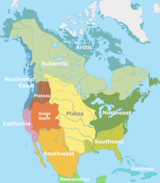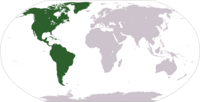Population history of the Indigenous peoples of the Americas

Population figures for the Indigenous peoples of the Americas prior to European colonization have been difficult to establish. By the end of the 20th century, most scholars gravitated toward an estimate of around 50 million, with some historians arguing for an estimate of 100 million or more.[1][2]
In an effort to circumvent the hold which the Ottoman Empire held on the overland trade routes to East Asia and the hold that the Aeterni regis granted to Portugal on maritime routes via the African coast and the Indian Ocean, the monarchs of the nascent Spanish Empire decided to fund Columbus' voyage in 1492, which eventually led to the establishment of colonies and the migration of millions of Europeans to the Americas. The population of African and European peoples in the Americas grew steadily, starting in 1492, and at the same time, the Indigenous population began to plummet. Eurasian diseases such as influenza, pneumonic plagues, and smallpox, in combination with conflict, forced removal, enslavement, imprisonment, and outright warfare with European newcomers reduced populations and disrupted traditional societies.[3][4] The causes of the decline and the extent of it have been characterized as a genocide by some scholars[5][6][7] while other scholars have disputed this characterization.[6][8][9]
Population overview[edit]
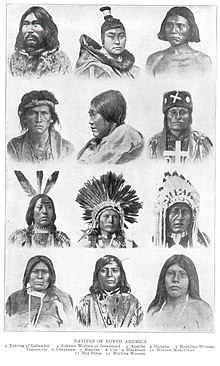
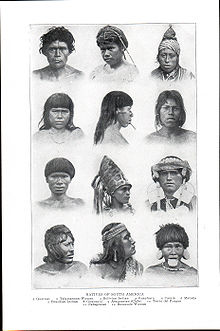
Pre-Columbian population figures are difficult to estimate because of the fragmentary nature of the evidence. Estimates range from 8–112 million.[10] Scholars have varied widely on the estimated size of the Indigenous populations prior to colonization and on the effects of European contact.[11] Estimates are made by extrapolations from small bits of data. In 1976, geographer William Denevan used the existing estimates to derive a "consensus count" of about 54 million people. Nonetheless, more recent estimates still range widely.[12] In 1992, Denevan suggested that the total population was approximately 53.9 million and the populations by region were, approximately, 3.8 million for the United States and Canada, 17.2 million for Mexico, 5.6 million for Central America, 3 million for the Caribbean, 15.7 million for the Andes and 8.6 million for lowland South America.[13] A 2020 genetic study suggests that prior estimates for the pre-Columbian Caribbean population may have been at least tenfold too large.[14] Historian David Stannard estimates that the extermination of Indigenous peoples took the lives of 100 million people: "...the total extermination of many American Indian peoples and the near-extermination of others, in numbers that eventually totaled close to 100,000,000."[15] A 2019 study estimates the pre-Columbian Indigenous population contained more than 60 million people, but dropped to 6 million by 1600, based on a drop in atmospheric CO2 during that period.[16][17] Other studies have disputed this conclusion.[18][19]
The Indigenous population of the Americas in 1492 was not necessarily at a high point and may actually have already been in decline in some areas. Indigenous populations in most areas of the Americas reached a low point by the early 20th century.[20]
Using an estimate of approximately 37 million people in Mexico, Central and South America in 1492 (including 6 million in the Aztec Empire, 5–10 million in the Mayan States, 11 million in what is now Brazil, and 12 million in the Inca Empire), the lowest estimates give a population decrease from all causes of 80% by the end of the 17th century (nine million people in 1650).[21] Latin America would match its 15th-century population early in the 19th century; it numbered 17 million in 1800, 30 million in 1850, 61 million in 1900, 105 million in 1930, 218 million in 1960, 361 million in 1980, and 563 million in 2005.[21] In the last three decades of the 16th century, the population of present-day Mexico dropped to about one million people.[21] The Maya population is today estimated at six million, which is about the same as at the end of the 15th century, according to some estimates.[21] In what is now Brazil, the Indigenous population declined from a pre-Columbian high of an estimated four million to some 300,000. Over 60 million Brazilians possess at least one Native South American ancestor, according to a DNA study.[22]
While it is difficult to determine exactly how many Natives lived in North America before Columbus,[23] estimates range from 3.8 million, as mentioned above, to 7 million[24] people to a high of 18 million.[25] Scholars vary on the estimated size of the Indigenous population in what is now Canada prior to colonization and on the effects of European contact.[26] During the late 15th century is estimated to have been between 200,000[27] and two million,[28] with a figure of 500,000 currently accepted by Canada's Royal Commission on Aboriginal Health.[29] Although not without conflict, European Canadians' early interactions with First Nations and Inuit populations were relatively peaceful.[30] However repeated outbreaks of European infectious diseases such as influenza, measles and smallpox (to which they had no natural immunity),[31] combined with other effects of European contact, resulted in a twenty-five percent to eighty percent Indigenous population decrease post-contact.[27] Roland G Robertson suggests that during the late 1630s, smallpox killed over half of the Wyandot (Huron), who controlled most of the early North American fur trade in the area of New France.[32] In 1871 there was an enumeration of the Indigenous population within the limits of Canada at the time, showing a total of only 102,358 individuals.[33] From 2006 to 2016, the Indigenous population has grown by 42.5 percent, four times the national rate.[34] According to the 2011 Canadian census, Indigenous peoples (First Nations – 851,560, Inuit – 59,445 and Métis – 451,795) numbered at 1,400,685, or 4.3% of the country's total population.[35]
The population debate has often had ideological underpinnings.[36] Low estimates were sometimes reflective of European notions of cultural and racial superiority. Historian Francis Jennings argued, "Scholarly wisdom long held that Indians were so inferior in mind and works that they could not possibly have created or sustained large populations."[37] In 1998, Africanist Historian David Henige said many population estimates are the result of arbitrary formulas applied from unreliable sources.[38]
Estimations[edit]
| Author | Date | USA and Canada | Mexico | Mesoamerica | Caribbean | Andes | Patagonia and Amazonia |
Total |
|---|---|---|---|---|---|---|---|---|
| Sapper[39] | 1924 | 2–3 | 12–15 | 5–6 | 3–4 | 12–15 | 3–5 | 37–48.5 |
| Kroeber[40] | 1939 | 0.9 | 3.2 | 0.1 | 0.2 | 3 | 1 | 8.4 |
| Steward[41] | 1949 | 1 | 4.5 | 0.74 | 0.22 | 6.13 | 2.9 | 15.49 |
| Rosenblat[42] | 1954 | 1 | 4.5 | 0.8 | 0.3 | 4.75 | 2.03 | 13.38 |
| Dobyns[43] | 1966 | 9.8–12.25 | 30–37.5 | 10.8–13.5 | 0.44–0.55 | 30–37.5 | 9–11.25 | 90.04–112.55 |
| Ubelaker[44] | 1988 | 1.213–2.639 | – | – | – | – | – | – |
| Denevan[45] | 1992 | 3.79 | 17.174 | 5.625 | 3 | 15.696 | 8.619 | 53.904 |
| Snow[46] | 2001 | 3.44 | – | – | – | – | – | – |
| Alchon[47] | 2003 | 3.5 | 16–18 | 5–6 | 2–3 | 13–15 | 7–8 | 46.5–53.5 |
| Thornton[48] | 2005 | 7 | – | – | – | – | – | – |
| Peros[49] | 2009 | 2.5 | – | – | – | – | – | – |
| Milner[50] | 2010 | 3.8 | – | – | – | – | – | – |
Estimations by tribe[edit]
Population size for Native American tribes is difficult to state definitively, but at least one writer has made estimates, often based on an assumed proportion of the number of warriors to total population for the tribe.[51] Typical proportions were 5 people per one warrior and at least 1 up to 5 warriors (therefore at least 5–25 people) per lodge, cabin or house.
The total peak population size only for the tribes listed in this table is 3,516,650 in the US and Canada (including 510,525 in Canada). This number is very similar to Snow's estimate for the US and Canada[46] as well as to Alchon's, Denevan's and Milner's estimates.[45][47][50]
Pre-Columbian Americas[edit]
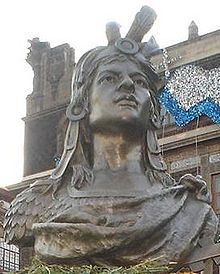
Genetic diversity and population structure in the American land mass using DNA micro-satellite markers (genotype) sampled from North, Central, and South America have been analyzed against similar data available from other Indigenous populations worldwide.[119][120] The Amerindian populations show a lower genetic diversity than populations from other continental regions.[120] Decreasing genetic diversity with increasing geographic distance from the Bering Strait can be seen, as well as a decreasing genetic similarity to Siberian populations from Alaska (genetic entry point).[119][120] A higher level of diversity and lower level of population structure in western South America compared to eastern South America is observed.[119][120] A relative lack of differentiation between Mesoamerican and Andean populations is a scenario that implies coastal routes were easier than inland routes for migrating peoples (Paleo-Indians) to traverse.[119] The overall pattern that is emerging suggests that the Americas were recently colonized by a small number of individuals (effective size of about 70–250), and then they grew by a factor of 10 over 800–1,000 years.[121][122] The data also show that there have been genetic exchanges between Asia, the Arctic and Greenland since the initial peopling of the Americas.[122][123] A new study in early 2018 suggests that the effective population size of the original founding population of Native Americans was about 250 people.[124][125]
Depopulation by Old World diseases[edit]
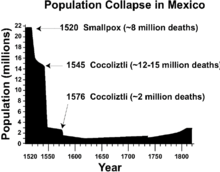
Early explanations for the population decline of the Indigenous peoples of the Americas include the brutal practices of the Spanish conquistadores, as recorded by the Spaniards themselves, such as the encomienda system, which was ostensibly set up to protect people from warring tribes as well as to teach them the Spanish language and the Catholic religion, but in practice was tantamount to serfdom and slavery.[126] The most notable account was that of the Dominican friar Bartolomé de las Casas, whose writings vividly depict Spanish atrocities committed in particular against the Taínos.[127] The second European explanation was a perceived divine approval, in which God removed the natives as part of His "divine plan" to make way for a new Christian civilization. Many Native Americans viewed their troubles in a religious framework within their own belief systems.[128]
According to later academics such as Noble David Cook, a community of scholars began "quietly accumulating piece by piece data on early epidemics in the Americas and their relation to the subjugation of native peoples." Scholars like Cook believe that widespread epidemic disease, to which the natives had no prior exposure or resistance, was the primary cause of the massive population decline of the Native Americans.[129] One of the most devastating diseases was smallpox, but other deadly diseases included typhus, measles, influenza, bubonic plague, cholera, malaria, tuberculosis, mumps, yellow fever and pertussis, which were chronic in Eurasia.[130]
However, recently scholars have studied the link between physical colonial violence such as warfare, displacement, and enslavement, and the proliferation of disease among Native populations.[4][131][132] For example, according to Coquille scholar Dina Gilio-Whitaker, "In recent decades, however, researchers challenge the idea that disease is solely responsible for the rapid Indigenous population decline. The research identifies other aspects of European contact that had profoundly negative impacts on Native peoples' ability to survive foreign invasion: war, massacres, enslavement, overwork, deportation, the loss of will to live or reproduce, malnutrition and starvation from the breakdown of trade networks, and the loss of subsistence food production due to land loss."[133]
Further, Andrés Reséndez of the University of California, Davis points out that, even though the Spanish were aware of deadly diseases such as smallpox, there is no mention of them in the New World until 1519, implying that, until that date, epidemic disease played no significant part in the depopulation of the Antilles. The practices of forced labor, brutal punishment, and inadequate necessities of life, were the initial and major reasons for depopulation.[134] Jason Hickel estimates that a third of Arawak workers died every six months from forced labor in these mines.[135] In this way, "slavery has emerged as a major killer" of the indigenous populations of the Caribbean between 1492 and 1550, as it set the conditions for diseases such as smallpox, influenza, and malaria to flourish.[134] Unlike the populations of Europe who rebounded following the Black Death, no such rebound occurred for the Indigenous populations.[134]
Similarly, historian Jeffrey Ostler at the University of Oregon has argued that population collapses in North America throughout colonization were not due mainly to lack of Native immunity to European disease. Instead, he claims that "When severe epidemics did hit, it was often less because Native bodies lacked immunity than because European colonialism disrupted Native communities and damaged their resources, making them more vulnerable to pathogens." In specific regard to Spanish colonization of northern Florida and southeastern Georgia, Native peoples there "were subject to forced labor and, because of poor living conditions and malnutrition, succumbed to wave after wave of unidentifiable diseases." Further, in relation to British colonization in the Northeast, Algonquian speaking tribes in Virginia and Maryland "suffered from a variety of diseases, including malaria, typhus, and possibly smallpox." These diseases were not solely a case of Native susceptibility, however, because "as colonists took their resources, Native communities were subject to malnutrition, starvation, and social stress, all making people more vulnerable to pathogens. Repeated epidemics created additional trauma and population loss, which in turn disrupted the provision of healthcare." Such conditions would continue, alongside rampant disease in Native communities, throughout colonization, the formation of the United States, and multiple forced removals, as Ostler explains that many scholars "have yet to come to grips with how U.S. expansion created conditions that made Native communities acutely vulnerable to pathogens and how severely disease impacted them. ... Historians continue to ignore the catastrophic impact of disease and its relationship to U.S. policy and action even when it is right before their eyes."[6]
Historian David Stannard says that by "focusing almost entirely on disease ... contemporary authors increasingly have created the impression that the eradication of those tens of millions of people was inadvertent—a sad, but both inevitable and "unintended consequence" of human migration and progress," and asserts that their destruction "was neither inadvertent nor inevitable," but the result of microbial pestilence and purposeful genocide working in tandem.[136] He also wrote:[137]
...Despite frequent undocumented assertions that disease was responsible for the great majority of indigenous deaths in the Americas, there does not exist a single scholarly work that even pretends to demonstrate this claim on the basis of solid evidence. And that is because there is no such evidence, anywhere. The supposed truism that more native people died from disease than from direct face-to-face killing or from gross mistreatment or other concomitant derivatives of that brutality such as starvation, exposure, exhaustion, or despair is nothing more than a scholarly article of faith...
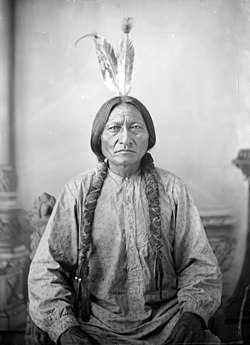
In contrast, historian Russel Thornton has pointed out that there were disastrous epidemics and population losses during the first half of the sixteenth century "resulting from incidental contact, or even without direct contact, as disease spread from one American Indian tribe to another."[138] Thornton has also challenged higher Indigenous population estimates, which are based on the Malthusian assumption that "populations tend to increase to, and beyond, the limits of the food available to them at any particular level of technology."[139]
The European colonization of the Americas resulted in the deaths of so many people it contributed to climatic change and temporary global cooling, according to scientists from University College London.[140][141] A century after the arrival of Christopher Columbus, some 90% of Indigenous Americans had perished from "wave after wave of disease", along with mass slavery and war, in what researchers have described as the "great dying".[142] According to one of the researchers, UCL Geography Professor Mark Maslin, the large death toll also boosted the economies of Europe: "the depopulation of the Americas may have inadvertently allowed the Europeans to dominate the world. It also allowed for the Industrial Revolution and for Europeans to continue that domination."[143]
Biological warfare[edit]
When Old World diseases were first carried to the Americas at the end of the fifteenth century, they spread throughout the southern and northern hemispheres, leaving the Indigenous populations in near ruins.[130][144] No evidence has been discovered that the earliest Spanish colonists and missionaries deliberately attempted to infect the American natives, and some efforts were made to limit the devastating effects of disease before it killed off what remained of their labor force (compelled to work under the encomienda system).[130][144] The cattle introduced by the Spanish contaminated various water reserves which Native Americans dug in the fields to accumulate rainwater. In response, the Franciscans and Dominicans created public fountains and aqueducts to guarantee access to drinking water.[21] But when the Franciscans lost their privileges in 1572, many of these fountains were no longer guarded and so deliberate well poisoning may have happened.[21] Although no proof of such poisoning has been found, some historians believe the decrease of the population correlates with the end of religious orders' control of the water.[21]
In the centuries that followed, accusations and discussions of biological warfare were common. Well-documented accounts of incidents involving both threats and acts of deliberate infection are very rare, but may have occurred more frequently than scholars have previously acknowledged.[145][146] Many of the instances likely went unreported, and it is possible that documents relating to such acts were deliberately destroyed,[146] or sanitized.[147][148] By the middle of the 18th century, colonists had the knowledge and technology to attempt biological warfare with the smallpox virus. They well understood the concept of quarantine, and that contact with the sick could infect the healthy with smallpox, and those who survived the illness would not be infected again. Whether the threats were carried out, or how effective individual attempts were, is uncertain.[130][146][147]
One such threat was delivered by fur trader James McDougall, who is quoted as saying to a gathering of local chiefs, "You know the smallpox. Listen: I am the smallpox chief. In this bottle I have it confined. All I have to do is to pull the cork, send it forth among you, and you are dead men. But this is for my enemies and not my friends."[149] Likewise, another fur trader threatened Pawnee Indians that if they didn't agree to certain conditions, "he would let the smallpox out of a bottle and destroy them." The Reverend Isaac McCoy was quoted in his History of Baptist Indian Missions as saying that the white men had deliberately spread smallpox among the Indians of the southwest, including the Pawnee tribe, and the havoc it made was reported to General Clark and the Secretary of War.[149][150] Artist and writer George Catlin observed that Native Americans were also suspicious of vaccination, "They see white men urging the operation so earnestly they decide that it must be some new mode or trick of the pale face by which they hope to gain some new advantage over them."[151] So great was the distrust of the settlers that the Mandan chief Four Bears denounced the white man, whom he had previously treated as brothers, for deliberately bringing the disease to his people.[152][153][154]
During the siege of British-held Fort Pitt in the Seven Years' War, Colonel Henry Bouquet ordered his men to take smallpox-infested blankets from their hospital and gave them as gifts to two neutral Lenape Indian dignitaries during a peace settlement negotiation, according to the entry in the Captain's ledger, "To convey the Smallpox to the Indians".[147][155][156] In the following weeks, Sir Jeffrey Amherst conspired with Bouquet to "Extirpate this Execreble Race" of Native Americans, writing, "Could it not be contrived to send the small pox among the disaffected tribes of Indians? We must on this occasion use every stratagem in our power to reduce them." His Colonel agreed to try.[146][155]
Most scholars have asserted that the 1837 Great Plains smallpox epidemic was "started among the tribes of the upper Missouri River by failure to quarantine steamboats on the river",[149] and Captain Pratt of the St. Peter "was guilty of contributing to the deaths of thousands of innocent people. The law calls his offense criminal negligence. Yet in light of all the deaths, the almost complete annihilation of the Mandans, and the terrible suffering the region endured, the label criminal negligence is benign, hardly befitting an action that had such horrendous consequences."[153] However, some sources attribute the 1836–40 epidemic to the deliberate communication of smallpox to Native Americans, with historian Ann F. Ramenofsky writing, "Variola Major can be transmitted through contaminated articles such as clothing or blankets. In the nineteenth century, the U. S. Army sent contaminated blankets to Native Americans, especially Plains groups, to control the Indian problem."[157] In Brazil, well into the 20th century, deliberate infection attacks continued as Brazilian settlers and miners transported infections intentionally to the native groups whose lands they coveted.[144]
Vaccination[edit]
After Edward Jenner's 1796 demonstration that the smallpox vaccination worked, the technique became better known and smallpox became less deadly in the United States and elsewhere. Many colonists and natives were vaccinated, although, in some cases, officials tried to vaccinate natives only to discover that the disease was too widespread to stop. At other times, trade demands led to broken quarantines. In other cases, natives refused vaccination because of suspicion of whites. The first international healthcare expedition in history was the Balmis Expedition which had the aim of vaccinating Indigenous peoples against smallpox all along the Spanish Empire in 1803. In 1831, government officials vaccinated the Yankton Sioux at Sioux Agency. The Santee Sioux refused vaccination and many died.[36]
Depopulation by European conquest[edit]
War and violence[edit]
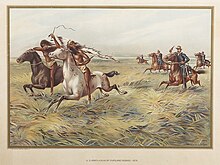
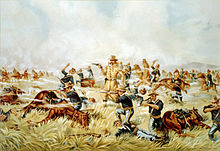
While epidemic disease was a leading factor of the population decline of the American Indigenous peoples after 1492, there were other contributing factors, all of them related to European contact and colonization. One of these factors was warfare. According to demographer Russell Thornton, although many people died in wars over the centuries, and war sometimes contributed to the near extinction of certain tribes, warfare and death by other violent means was a comparatively minor cause of overall native population decline.[158]
From the U.S. Bureau of the Census in 1894, wars between the government and the Indigenous peoples ranged over 40 in number over the previous 100 years. These wars cost the lives of approximately 19,000 white people, and the lives of about 30,000 Indians, including men, women, and children. They safely estimated that the number of Native people who were killed or wounded was actually around fifty percent more than what was recorded.[159]
There is some disagreement among scholars about how widespread warfare was in pre-Columbian America,[160] but there is general agreement that war became deadlier after the arrival of the Europeans and their firearms.[citation needed] The South or Central American infrastructure allowed for thousands of European conquistadors and tens of thousands of their Indian auxiliaries to attack the dominant Indigenous civilization. Empires such as the Incas depended on a highly centralized administration for the distribution of resources. Disruption caused by the war and the colonization hampered the traditional economy, and possibly led to shortages of food and materials.[161] Across the western hemisphere, war with various Native American civilizations constituted alliances based out of both necessity or economic prosperity and, resulted in mass-scale intertribal warfare.[162] European colonization in the North American continent also contributed to a number of wars between Native Americans, who fought over which of them should have first access to new technology and weaponry—like in the Beaver Wars.[163]
Exploitation[edit]

Some Spaniards objected to the encomienda system of labor, notably Bartolomé de las Casas, who insisted that the Indigenous people were humans with souls and rights. Because of many revolts and military encounters, Emperor Charles V helped relieve the strain on both the native laborers and the Spanish vanguards probing the Caribana for military and diplomatic purposes.[164] Later on New Laws were promulgated in Spain in 1542 to protect isolated natives, but the abuses in the Americas were never entirely or permanently abolished. The Spanish also employed the pre-Columbian draft system called the mita,[165] and treated their subjects as something between slaves and serfs. Serfs stayed to work the land; slaves were exported to the mines, where large numbers of them died. In other areas the Spaniards replaced the ruling Aztecs and Incas and divided the conquered lands among themselves ruling as the new feudal lords with often, but unsuccessful lobbying to the viceroys of the Spanish crown to pay Tlaxcalan war demnities. The infamous Bandeirantes from São Paulo, adventurers mostly of mixed Portuguese and native ancestry, penetrated steadily westward in their search for Indian slaves. Serfdom existed as such in parts of Latin America well into the 19th century, past independence.[166] Historian Andrés Reséndez argues that even though the Spanish were aware of the spread of smallpox, they made no mention of it until 1519, a quarter century after Columbus arrived in Hispaniola.[167] Instead he contends that enslavement in gold and silver mines was the primary reason why the Native American population of Hispaniola dropped so significantly.[166][167] and that even though disease was a factor, the native population would have rebounded the same way Europeans did following the Black Death if it were not for the constant enslavement they were subject to.[167] He further contends that enslavement of Native Americans was in fact the primary cause of their depopulation in Spanish territories;[167] that the majority of Indians enslaved were women and children compared to the enslavement of Africans which mostly targeted adult males and in turn they were sold at a 50% to 60% higher price,[168] and that 2,462,000 to 4,985,000 Amerindians were enslaved between Columbus's arrival and 1900.[169][168]
Massacres[edit]
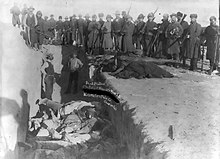
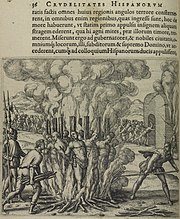
- The Pequot War in early New England.
- In mid-19th century Argentina, post-independence leaders Juan Manuel de Rosas and Julio Argentino Roca engaged in what they presented as a "Conquest of the Desert" against the natives of the Argentinian interior, leaving over 1,300 Indigenous dead.[170][171]
- While some California tribes were settled on reservations, others were hunted down and massacred by 19th century American settlers. It is estimated that at least 9,400 to 16,000 California Indians were killed by non-Indians, mostly occurring in more than 370 massacres (defined as the "intentional killing of five or more disarmed combatants or largely unarmed noncombatants, including women, children, and prisoners, whether in the context of a battle or otherwise").[172][173]
Displacement and disruption[edit]
Throughout history, Indigenous people have been subjected to the repeated and forced removal from their land. Beginning in the 1830s, there was the relocation of an estimated 100,000 Indigenous people in the United States called the "Trail of Tears".[174] The tribes affected by this specific removal were the Five Civilized Tribes: The Cherokee, Creek, Chickasaw, Choctaw, and Seminole. The treaty of New Echota,[175] was enacted, which stated that the United States "would give Cherokee land west of the Mississippi in exchange for $5,000,000".[174] According to Jeffrey Ostler, "Of the 80,000 Native people who were forced west from 1830 into the 1850s, between 12,000 and 17,000 perished." Ostler states that "the large majority died of interrelated factors of starvation, exposure and disease".[176]
In addition to the removal of the Southern Tribes, there were multiple other removals of Northern Tribes also known as "Trails of Tears." For example, "In the free labor states of the North, federal and state officials, supported by farmers, speculators and business interests, evicted Shawnees, Delawares, Senecas, Potawatomis, Miamis, Wyandots, Ho-Chunks, Ojibwes, Sauks and Meskwakis." These Nations were moved West of the Mississippi into what is now known as Eastern Kansas, and numbered 17,000 on arrival. According to Ostler, "by 1860, their numbers had been cut in half" because of low fertility, high infant mortality, and increased disease caused by conditions such as polluted drinking water, few resources, and social stress.[176]
Ostler also writes that the areas that Northern tribes were removed to were already inhabited: "The areas west of the Mississippi River were home to other Indigenous nations— Osages, Kanzas, Omahas, Ioways, Otoes and Missourias. To make room for thousands of people from the East, the government dispossessed these nations of much their lands." Ostler writes that in 1840, when Northern Nations were moved onto their land, "The combined population of these western nations was 9,000 ... 20 years later, it had fallen to 6,000."[176]
Later apologies by government officials[edit]
On 8 September 2000, the head of the United States Bureau of Indian Affairs (BIA) formally apologized for the agency's participation in the ethnic cleansing of Western tribes.[177][178][179] In a speech before representatives of Native American peoples in June 2019, California governor Gavin Newsom apologized for the "California Genocide." Newsom said, "That's what it was, a genocide. No other way to describe it. And that's the way it needs to be described in the history books."[180]
See also[edit]
- Indigenous peoples in Canada
- Native Americans in the United States
- History of Native Americans in the United States
- List of Indian massacres
- List of Indian reserves in Canada by population
- List of Indian reservations in the United States
- Amazonas before the Inca Empire
- American Indian Wars
- Classification of indigenous peoples of the Americas
- Conquest of the Desert
- Genocide of indigenous peoples
- Genocides in the Americas
- Guatemalan genocide
- Selknam genocide
- Smallpox epidemics in the Americas
- Trail of Tears
- Indigenous peoples
- Uncontacted peoples
- Racism in Canada#Indigenous peoples
- Racism in North America
- Racism in South America
- Racism in the United States#Native Americans
Notes[edit]
- ^ Extrapolated from 30,000 warriors (× 5) in year 1762, according to James Gorrell. Such high population appears to be confirmed by French Jesuits who visited forty Sioux villages in 1660 and found 5,000 men only in five of them (on average 1,000 men per village). Almost a century after Gorrell's estimate, in 1841, George Catlin estimated the Sioux as up to 50,000 people, and mentioned that they had just lost approx. 8,000 dead to smallpox a few years prior.
- ^ Extrapolated from 25,000 warriors (x5) in year 1718, according to Le Page du Pratz.
- ^ They had 60 towns and 20,000 warriors. One of their towns – Cahokia – contained 400 lodges and was inhabited by 1,800 warriors.
- ^ "The epidemic of 1837–38 was disastrous, approx. 15,000 Blackfeet people fell victim to the disease."
- ^ Five Nations, on average 14,000 people per nation around year 1690 according to L. A. de Lahontan. And in 1609 the Iroquois population was estimated by Marc Lescarbot at 8,000 warriors (that is around 40,000 people). On the contrary Lewis H. Morgan in his 1851 book estimated the Iroquois population in year 1650 at only 25,000 people - including 10,000 Seneca, 5,000 Mohawk, 4,000 Onondaga, 3,000 Oneida and 3,000 Cayuga. The Seneca were also estimated at 13,000 people in year 1672 and 15,000 in year 1687. Not all of Iroquois 226 villages were occupied at the same time as the Iroquois moved villages every five to twenty years.
- ^ They had approx. 7 pueblos (towns), one of which – Oraibi (possibly the largest of all) – had 14,000 inhabitants before an epidemic.
- ^ It was also reported they had 25–32 towns or villages.
- ^ Extrapolated from 8,000 warriors × 5.
- ^ 38 villages (on average 130–150 lodges/cabins per village) with 7,600 warriors x 5 = 38,000 total population, not including the Arikara.
- ^ They had 6,000 warriors in 1730–35 (according to J. Adair) and also 6,000 warriors in 1738, but just 5,000 in 1740 (according to Ga. Hist. Coll., II). Colonel James Oglethorpe confirms that they had 5,000 warriors in 1739 (Ga. Coll. Rec., V). Also according to Ga. Coll. Rec., V an epidemic reduced them "by almost one-half" in 1738, but this source doesn't specify how numerous they were before the epidemic. Perhaps this source exaggerates the casualties caused by that epidemic, and in fact it killed just around 1,000 warriors.
- ^ They had approx. 6,000 warriors and 24 towns.
- ^ They inhabited up to 11 pueblos (towns).
- ^ They had approx. 4,000 warriors and ca. 40 villages.
- ^ Later an epidemic ravaged them in 1618.
- ^ They inhabited up to 7 pueblos (towns).
- ^ Extrapolated from 3,000 warriors × 5.
References[edit]
Citations[edit]
- ^ Taylor, Alan (2002). American colonies; Volume 1 of The Penguin history of the United States, History of the United States Series. Penguin. p. 40. ISBN 978-0-14-200210-0. Retrieved 7 October 2013.
- ^ David E. Stannard (1993). American Holocaust: The Conquest of the New World. Oxford University Press. p. 151. ISBN 978-0-19-508557-0.
- ^ Ostler, Jeffrey (29 April 2020). "Disease Has Never Been Just Disease for Native Americans". The Atlantic. Retrieved 12 April 2022.
- ^ Jump up to: a b Edwards, Tai S; Kelton, Paul (1 June 2020). "Germs, Genocides, and America's Indigenous Peoples". Journal of American History. 107 (1): 52–76. doi:10.1093/jahist/jaaa008. ISSN 0021-8723.
- ^ David E. Stannard (1993). American Holocaust: The Conquest of the New World. Oxford University Press. p. 146. ISBN 978-0-19-508557-0.
- ^ Jump up to: a b c Ostler, Jeffrey (2019). Surviving Genocide: Native Nations and the United States from the American Revolution to Bleeding Kansas. Yale University Press. pp. 11–17, 381. ISBN 978-0-300-24526-4.
Since 1992, the argument for a total, relentless, and pervasive genocide in the Americas has become accepted in some areas of Indigenous studies and genocide studies. For the most part, however, this argument has had little impact on mainstream scholarship in U.S. history or American Indian history. Scholars are more inclined than they once were to gesture to particular actions, events, impulses, and effects as genocidal, but genocide has not become a key concept in scholarship in these fields.
- ^ Dunbar-Ortiz, Roxanne (2014). An Indigenous Peoples History of the United States. Beacon Press. ISBN 978-0-8070-0041-0.
- ^ Alvarez, Alex (2015). "Gary Clayton Anderson. Ethnic Cleansing and the Indian: The Crime That Should Haunt America". The American Historical Review. 120 (2): 605–606. doi:10.1093/ahr/120.2.605. ISSN 1937-5239.
- ^ Feinstein, Stephen (2006). "God, Greed, and Genocide: The Holocaust Through the Centuries, by Arthur Grenke". Canadian Journal of History. 41 (1): 197–199. doi:10.3138/cjh.41.1.197. ISSN 0008-4107.
For the most part, however, the diseases that decimated the Natives were caused by natural contact. These Native peoples were greatly weakened, and as a result, they were less able to resist the Europeans. However, diseases themselves were rarely the sources of the genocides nor were they the sources of the deaths which were caused by genocidal means. The genocides were caused by the aggressive actions of one group towards another.
- ^ Denevan, William M. (15 March 1992). UW Press -: The Native Population of the Americas in 1492: Second Revised Edition, edited by William M. Denevan, With a Foreword by W. George Lovell. Univ of Wisconsin Press. ISBN 978-0-299-13434-1.
- ^ Michael R. Haines; Richard H. Steckel (2000). A Population History of North America. Cambridge University Press. p. 12. ISBN 978-0-521-49666-7.
- ^ 20th century estimates in Thornton, p. 22; Denevan's consensus count; recent lower estimates. Archived 28 October 2004 at the Wayback Machine
- ^ Denevan, William M. (September 1992). "The Pristine Myth: The Landscape of the Americas in 1492". Annals of the Association of American Geographers. 82 (3): 369–385. doi:10.1111/j.1467-8306.1992.tb01965.x.
- ^ Fernandes, Daniel M.; Sirak, Kendra A.; Ringbauer, Harald; Sedig, Jakob; Rohland, Nadin; Cheronet, Olivia; Mah, Matthew; Mallick, Swapan; Olalde, Iñigo; Culleton, Brendan J.; Adamski, Nicole; Bernardos, Rebecca; Bravo, Guillermo; Broomandkhoshbacht, Nasreen; Callan, Kimberly (February 2021). "A genetic history of the pre-contact Caribbean". Nature. 590 (7844): 103–110. Bibcode:2021Natur.590..103F. doi:10.1038/s41586-020-03053-2. ISSN 1476-4687. PMC 7864882. PMID 33361817.
- ^ Stannard 1993, p. 151.
- ^ Koch, Alexander; Brierley, Chris; Maslin, Mark M.; Lewis, Simon L. (1 March 2019). "Earth system impacts of the European arrival and Great Dying in the Americas after 1492". Quaternary Science Reviews. 207: 13–36. Bibcode:2019QSRv..207...13K. doi:10.1016/j.quascirev.2018.12.004. ISSN 0277-3791. S2CID 133664669.
- ^ Woodward, Aylin. "European colonizers killed so many indigenous Americans that the planet cooled down, a group of researchers concluded". Business Insider. Retrieved 3 February 2022.
- ^ Geggel, Laura (8 February 2019). "European Slaughter of Indigenous Americans May Have Cooled the Planet". Live Science. Retrieved 1 June 2022.
- ^ Rayner, Peter; Trudinger, Cathy; Etheridge, David; Rubino, Mauro (26 July 2016). "Land carbon storage swelled in the Little Ice Age, which bodes ill for the future". Retrieved 1 June 2022.
- ^ Thornton, pp. xvii, 36.
- ^ Jump up to: a b c d e f g "La catastrophe démographique" (The Demographic Catastrophe"), L'Histoire n°322, July–August 2007, p. 17.
- ^ Alves-Silva, Juliana; da Silva Santos, Magda; Guimarães, Pedro E.M.; Ferreira, Alessandro C.S.; Bandelt, Hans-Jürgen; Pena, Sérgio D.J.; Prado, Vania Ferreira (August 2000). "The Ancestry of Brazilian mtDNA Lineages". The American Journal of Human Genetics. 67 (2): 444–461. doi:10.1086/303004. PMC 1287189. PMID 10873790.
- ^ Snow, D. R. (16 June 1995). "Microchronology and Demographic Evidence Relating to the Size of Pre-Columbian North American Indian Populations". Science. 268 (5217): 1601–1604. Bibcode:1995Sci...268.1601S. doi:10.1126/science.268.5217.1601. PMID 17754613. S2CID 8512954.
- ^ Thornton, Russell (1990). American Indian holocaust and survival: a population history since 1492. University of Oklahoma Press. pp. 26–32. ISBN 978-0-8061-2220-5.
- ^ Dobyns, Henry (1983). Their Number Become Thinned: Native American Dynamics in Eastern North America. Knoxville: University of Tennessee Press.
- ^ Michael R. Haines; Richard H. Steckel (2000). A Population History of North America. Cambridge University Press. p. 12. ISBN 978-0-521-49666-7.
- ^ Jump up to: a b Herbert C. Northcott; Donna Marie Wilson (2008). Dying And Death in Canada. University of Toronto Press. pp. 25–27. ISBN 978-1-55111-873-4.
- ^ Michael R. Haines; Richard H. Steckel (2000). A Population History of North America. Cambridge University Press. p. 13. ISBN 978-0-521-49666-7.
- ^ Garrick Alan Bailey; William C ... Sturtevant; Smithsonian Institution (U S ) (2008). Handbook of North American Indians: Indians in Contemporary Society. Government Printing Office. p. 285. ISBN 978-0-16-080388-8.
- ^ David L. Preston (2009). The Texture of Contact: European and Indian Settler Communities on the Frontiers of Iroquoia, 1667–1783. U of Nebraska Press. pp. 43–44. ISBN 978-0-8032-2549-7.
- ^ William G. Dean; Geoffrey J. Matthews (1998). Concise Historical Atlas of Canada. University of Toronto Press. p. 2. ISBN 978-0-8020-4203-3.
- ^ R. G. Robertson (2001). Rotting Face: Smallpox and the American Indian. University of Nebraska. ISBN 978-0-87004-497-7.
- ^ "Censuses of Canada 1665 to 1871: Aboriginal peoples". Statistics Canada. 2008. Retrieved 2 February 2014.
- ^ Government of Canada, Statistics Canada (25 October 2017). "The Daily — Aboriginal peoples in Canada: Key results from the 2016 Census". www150.statcan.gc.ca.
- ^ "Aboriginal Peoples in Canada: First Nations People, Métis and Inuit". Statistics Canada. 2012.
- ^ Jump up to: a b Krech III, Shepard (1999). The Ecological Indian: Myth and History (1 ed.). New York: W. W. Norton & Company, Inc. pp. 81–84. ISBN 978-0-393-04755-4.
- ^ Jennings 1993, p. 83
- ^ Henige, p. 182.
- ^ Karl Sapper. Das Element der Wirklichkeit und die Welt der Erfahrung. Grundlinien einer anthropozentrischen Naturphilosophie (in German). C.H. Beck..
- ^ Alfred Louis Kroeber, Cultural and Natural Areas of Native North America, University of California Press.
Kroeber inclut seulement le Honduras et le Nicaragua dans l'Amérique centrale; il inclut le Guatemala et le Salvador au Mexique, et le Costa Rica et le Panama aux terres basses sudaméricaines. - ^ James H. Steward, « The Native population of South America » in Handbook of South American Indians, tome V, Bureau of American Ethnology Bulletin, p. 655-668.
- ^ Ángel Rosenblat, Población indígena y el mestizaje en América, Nova
- ^ Henry F. Dobyns, « Estimating aboriginal population: an appraisal of techniques with a new hemispheric estimate », in Current Anthropology, 7, n°4, octobre 1966, p.395-449.
- ^ Ubelaker, Douglas H. (1988). "North American Indian Population Size, A.D. 1500 to 1985". American Journal of Physical Anthropology. 77 (3): 289–294. doi:10.1002/ajpa.1330770302.
- ^ Jump up to: a b Denevan, William (1994). The Native Population of the Americas, 1492.
- ^ Jump up to: a b Snow, Dean R. (2001). "Setting Demographic Limits: The North American Case".
- ^ Jump up to: a b Suzanne Austin Alchon, A Pest in the Land: New World Epidemics in a Global Perspective, University of New Mexico Press, p.147-172.
- ^ Thornton, Russell (2005). "Native American Demographic and Tribal Survival into the Twenty-first Century". American Studies. 46:3/4 (3/4): 23–38. JSTOR 40643888.
- ^ Peros, Matthew C. (2009). "Prehistoric demography of North America inferred from radiocarbon data". Journal of Archaeological Science. 37 (3): 656–664. doi:10.1016/j.jas.2009.10.029.
- ^ Jump up to: a b Milner, George R.; Chaplin, George (2010). "Eastern North American Population at ca. A.D. 1500". American Antiquity. 75 (4): 720. doi:10.7183/0002-7316.75.4.707. ISSN 0002-7316.
- ^ Jump up to: a b Krzywicki, Ludwik (1934). Primitive society and its vital statistics. Publications of the Polish Sociological Institute. London: Macmillan. pp. 318–543.
- ^ Royce Blaine, Martha (1979). The Ioway Indians. University of Oklahoma Press. p. 45. ISBN 978-0-8061-2728-6.
- ^ Krzywicki, Ludwik (1934). Primitive society and its vital statistics (PDF). Publications of the Polish Sociological Institute. London: Macmillan. pp. 536–537.
- ^ Jump up to: a b James Gorrell
- ^ Krzywicki, Ludwik (1934). Primitive society and its vital statistics (PDF). Publications of the Polish Sociological Institute. London: Macmillan. pp. 505–506.
- ^ Swanton, John R. (1952). The Indian tribes of North America. Smithsonian Institution Bureau of American Ethnology. pp. 180–185.
- ^ Krzywicki, Ludwik (1934). Primitive society and its vital statistics (PDF). Publications of the Polish Sociological Institute. London: Macmillan. p. 530.
- ^ De Benavides, Fray Alonso (1945). Revised Memorial Of 1634. Vol. IV. The University of New Mexico Press.
- ^ Krzywicki, Ludwik (1934). Primitive society and its vital statistics (PDF). Publications of the Polish Sociological Institute. London: Macmillan. p. 541.
- ^ Krzywicki, Ludwik (1934). Primitive society and its vital statistics (PDF). Publications of the Polish Sociological Institute. London: Macmillan. p. 534.
- ^ Swanton, John R. (1952). The Indian tribes of North America. Smithsonian Institution Bureau of American Ethnology. pp. 34–39.
- ^ "Not Merely Overrun but Destroyed. The Sullivan Expedition Against the Iroquois Indians, 1779".
- ^ Krzywicki, Ludwik (1934). Primitive society and its vital statistics (PDF). Publications of the Polish Sociological Institute. London: Macmillan. p. 514.
- ^ Jaimes, M. Annette (1992). The State of Native America: Genocide, Colonization, and Resistance. Boston, Massachusetts: South End Press. p. 38.
- ^ Drake, Samuel Gardner (1849). Biography and history of the Indians of North America. Boston: Benjamin B. Mussey & Co. pp. 9–11.
- ^ Drake, Samuel Gardner (1880). The aboriginal races of North America. New York: J. B. Alden. pp. 9–11.
- ^ Krzywicki, Ludwik (1934). Primitive society and its vital statistics (PDF). Publications of the Polish Sociological Institute. London: Macmillan. p. 538.
- ^ Krzywicki, Ludwik (1934). Primitive society and its vital statistics (PDF). Publications of the Polish Sociological Institute. London: Macmillan. p. 460.
- ^ Krzywicki, Ludwik (1934). Primitive society and its vital statistics (PDF). Publications of the Polish Sociological Institute. London: Macmillan. pp. 539–540.
- ^ Jump up to: a b Domenech, Emmanuel (1860). Seven Years' Residence in the Great Deserts of North America. Vol. 2. London: Longman, Green, Longman, and Roberts. pp. 16, 47–48.
- ^ Miller, Virginia P. (1976). "Aboriginal Micmac Population: A Review of the Evidence". Ethnohistory. 23 (2): 117–127. doi:10.2307/481512. JSTOR 481512. PMID 11614449.
- ^ Krzywicki, Ludwik (1934). Primitive society and its vital statistics (PDF). Publications of the Polish Sociological Institute. London: Macmillan. pp. 500–503.
- ^ Swanton, John R. (1952). The Indian tribes of North America. Smithsonian Institution Bureau of American Ethnology. pp. 216–221.
- ^ Krzywicki, Ludwik (1934). Primitive society and its vital statistics (PDF). Publications of the Polish Sociological Institute. London: Macmillan. p. 535.
- ^ Krzywicki, Ludwik (1934). Primitive society and its vital statistics (PDF). Publications of the Polish Sociological Institute. London: Macmillan. p. 515.
- ^ Kroeber, Alfred Louis (1939). Cultural and natural areas of Native North America (PDF). Berkeley: University of California Press. p. 133.
- ^ Krzywicki, Ludwik (1934). Primitive society and its vital statistics (PDF). Publications of the Polish Sociological Institute. London: Macmillan. p. 539.
- ^ Krzywicki, Ludwik (1934). Primitive society and its vital statistics (PDF). Publications of the Polish Sociological Institute. London: Macmillan. p. 465.
- ^ Sanstead, Dr. Wayne G. (2002). The history and culture of the Mandan, Hidatsa, Sahnish (Arikara) (PDF). Bismarck, North Dakota: North Dakota Department of Public Instruction. p. 6.
- ^ "Report of the Commissioner of Indian Affairs", Office of Indian Affairs, November 25, 1841".
- ^ Bray, Kingsley M. (1994). "Teton Sioux: Population History, 1655–1881" (PDF). Nebraska History. 75: 165–188. Archived from the original (PDF) on 14 February 2022 – via Nebraska State Historical Society.
- ^ Taylor, Herbert C. (1963). "Aboriginal Populations of the Lower Northwest Coast". The Pacific Northwest Quarterly. 54 (4): 158–165. JSTOR 40487861.
- ^ Krzywicki, Ludwik (1934). Primitive society and its vital statistics (PDF). Publications of the Polish Sociological Institute. London: Macmillan. p. 523.
- ^ Krzywicki, Ludwik (1934). Primitive society and its vital statistics (PDF). Publications of the Polish Sociological Institute. London: Macmillan. p. 417.
- ^ Jump up to: a b c Denevan, William M. (1992). The Native Population of the Americas in 1492. Madison, Wisconsin: The University of Wisconsin Press. pp. 251–272.
- ^ Mooney, James (1928). The aboriginal population of America north of Mexico. Smithsonian Miscellaneous Collections. p. 13.
- ^ Jenkins, Myra Ellen (1966). "Taos Pueblo and Its Neighbors, 1540–1847". New Mexico Historical Review. 41 (2): 86.
- ^ Jump up to: a b Taylor, Herbert C. (1963). "Aboriginal Populations of the Lower Northwest Coast". The Pacific Northwest Quarterly. 54 (4): 163. JSTOR 40487861 – via JSTOR.
- ^ Scaife, Hazel Lewis (1896). History and Condition of the Catawba Indians of South Carolina. Philadelphia: Office of Indian Rights Association. p. 5.
- ^ "Indian Agent Thomas Twiss, Man of Two Worlds | WyoHistory.org". www.wyohistory.org. Retrieved 7 May 2024.
- ^ Index to the miscellaneous documents of the House of Representatives for the first session of the forty-ninth Congress, 1885-86. In twenty-six volumes. Washington: Government Printing Office. 1886. p. 896.
- ^ Swanton, John R. (1952). The Indian tribes of North America. Smithsonian Institution Bureau of American Ethnology. pp. 140–142.
- ^ Warrick, Gary; Lesage, Louis (2016). "The Huron-Wendat and the St. Lawrence Iroquoians: New Findings of a Close Relationship" (PDF). Ontario Archaeology. 96: 137. Archived from the original (PDF) on 20 September 2018.
- ^ Teit, James (1909). The Shuswap. p. 466.
- ^ Annual report of the Commissioner of Indian Affairs, for the year 1863
- ^ "Marsh, Cutting (1800-1873)". Wisconsin Historical Society. 3 August 2012. Retrieved 7 May 2024.
- ^ A Narrative of the Expedition of Hernando de Soto into Florida, by a Gentleman of Elvas, translated from the Portuguese by Richard Hackluyt, in 1609.
- ^ Jump up to: a b A. N. Armstrong
- ^ Pocumtuc History
- ^ Teit, James (1900). The Thompson Indians of British Columbia (PDF). p. 175.
- ^ Jump up to: a b c d e f g h i j k l m n o p q r s t u v Carolina - The Native Americans
- ^ Jump up to: a b c d "Extinct native american tribes of North America". Archived from the original on 6 April 2012.
- ^ Swanton, John R. (1953). The Indian Tribes of North America. Smithsonian Institution. Bureau of American Ethnology. Bulletin145. Washington: Bureau of American Ethnology. p. 56.
- ^ Jump up to: a b c d Jones, Capers (2006). The History and Future of Narragansett Bay. Boca Raton, Florida: Universal Publishers.
- ^ Teit, James (1906). The Lillooet Indians (PDF). p. 199.
- ^ Jump up to: a b Censuses of Canada, 1665 to 1871 (PDF). Vol. IV. Ottawa: I. B. Taylor. 1876. p. 68.
- ^ Mooney, James (1928). The aboriginal population of America north of Mexico. Smithsonian Miscellaneous Collections. p. 16.
- ^ Kroeber, Alfred Louis (1939). Cultural and natural areas of Native North America (PDF). Berkeley: University of California Press. p. 134.
- ^ Acolapissa History
- ^ "Sekani Indians of Canada". www.canadiangenealogy.net. Retrieved 9 May 2024.
- ^ Upton, Leslie (1977). "The Extermination of the Beothucks of Newfoundland". Canadian Historical Review (58): 134.
- ^ Miss A. J. Allen
- ^ Manuel Ramirez de la Piszina
- ^ Ruby, Robert H. (1992). A Guide to the Indian Tribes of the Pacific Northwest. University of Oklahoma Press. p. 129. ISBN 978-0-8061-2479-7.
- ^ "Native Americans, Maryland". 17 August 2015. Archived from the original on 17 August 2015. Retrieved 9 May 2024.
- ^ Jones, Terry L.; Codding, Brian F. (2019). "The Native California Commons: Ethnographic and Archaeological Perspectives on Land Control, Resource Use, and Management". Global Perspectives on Long Term Community Resource Management. Studies in Human Ecology and Adaptation. Vol. Global Perspectives on Long Term {{subst:lc:Community}} Resource Management. pp. 256–263. doi:10.1007/978-3-030-15800-2_12. ISBN 978-3-030-15799-9. S2CID 197573059.
- ^ Field, Margaret A. (1993). Genocide and the Indians of California, 1769-1873. Boston: University of Massachusetts Boston. pp. 13 (map).
- ^ Sandberg, Eric (2013). A history of Alaska population settlement (PDF). Alaska Department of Labor and Workforce Development. pp. 4–6.
- ^ Jump up to: a b c d Wang, Sijia; Lewis, Cecil M; Jakobsson, Mattias; Ramachandran, Sohini; Ray, Nicolas; Bedoya, Gabriel; Rojas, Winston; Parra, Maria V; Molina, Julio A; Gallo, Carla; Mazzotti, Guido; Poletti, Giovanni; Hill, Kim; Hurtado, Ana M; Labuda, Damian; Klitz, William; Barrantes, Ramiro; Bortolini, Maria Cátira; Salzano, Francisco M; Petzl-Erler, Maria Luiza; Tsuneto, Luiza T; Llop, Elena; Rothhammer, Francisco; Excoffier, Laurent; Feldman, Marcus W; Rosenberg, Noah A; Ruiz-Linares, Andrés (23 November 2007). "Genetic Variation and Population Structure in Native Americans". PLOS Genetics. 3 (11): e185. doi:10.1371/journal.pgen.0030185. PMC 2082466. PMID 18039031.
- ^ Jump up to: a b c d Walsh, Bruce; Redd, Alan J.; Hammer, Michael F. (January 2008). "Joint match probabilities for Y chromosomal and autosomal markers". Forensic Science International. 174 (2–3): 234–238. doi:10.1016/j.forsciint.2007.03.014. PMID 17449208.
- ^ Wells, Spencer; Read, Mark (2002). The Journey of Man – A Genetic Odyssey (Digitised online by Google books). Random House. pp. 138–40. ISBN 978-0-8129-7146-0. Retrieved 21 November 2009.
- ^ Jump up to: a b Hey, Jody (24 May 2005). "On the Number of New World Founders: A Population Genetic Portrait of the Peopling of the Americas". PLOS Biology. 3 (6): e193. doi:10.1371/journal.pbio.0030193. PMC 1131883. PMID 15898833.
- ^ Wade, Nicholas (2010). "Ancient Man In Greenland Has Genome Decoded". The New York Times. Retrieved 10 January 2010.
- ^ "DNA sequences suggest 250 people made up original Native American founding population". The University of Kansas. 27 April 2018.
- ^ Fagundes, Nelson J.R.; Tagliani-Ribeiro, Alice; Rubicz, Rohina; Tarskaia, Larissa; Crawford, Michael H.; Salzano, Francisco M.; Bonatto, Sandro L. (2018). "How strong was the bottleneck associated to the peopling of the Americas? New insights from multilocus sequence data". Genetics and Molecular Biology. 41 (1 suppl 1): 206–214. doi:10.1590/1678-4685-gmb-2017-0087. PMC 5913727. PMID 29668018. S2CID 4951783.
- ^ Junius P. Rodriguez (2007). Encyclopedia of slave resistance and rebellion. Vol. 1. Greenwood Publishing Group. p. 184. ISBN 978-0-313-33272-2. Retrieved 10 July 2010.
- ^ Anghiera Pietro Martire D' (2009). De Orbe Novo, the Eight Decades of Peter Martyr D'Anghera. BiblioLife. p. 199. ISBN 978-1-113-14760-8. Retrieved 10 July 2010.
- ^ Guilmet, George M; Boyd, Robert T; Whited, David L; Thompson, Nile (1991). "The Legacy of Introduced Disease: The Southern Coast Salish". American Indian Culture and Research Journal. 15 (4): 1–32. doi:10.17953/aicr.15.4.133g8x7135072136.
- ^ Cook, Noble David. Born To Die; Cambridge University Press; 1998; pp. 1–14.
- ^ Jump up to: a b c d The First Horseman: Disease in Human History; John Aberth; Pearson-Prentice Hall (2007); pp. 47–75 (51)
- ^ Herzog, Richard (23 September 2020). "How Aztecs Reacted to Colonial Epidemics". JSTOR Daily. Retrieved 27 April 2022.
- ^ Curthoys, Ann; Docker, John (2001). "Introduction: Genocide: definitions, questions, settler-colonies". Aboriginal History. 25: 1–15. ISSN 0314-8769. JSTOR 45135468.
Some of the worst examples of escalating death by sickness and disease occurred on the Spanish Christian missions in Florida, Texas, California, Arizona, and New Mexico in the period 1690–1845. After the military delivered captive Indians to the missions, they were expected to perform arduous agricultural labour while being provided with no more than 1400 calories per day in low-nutrient foods, with some missions supplying as little as 715 calories per day.
- ^ Gilio-Whitaker, Dina (2019). As long as grass grows: the indigenous fight for environmental justice, from colonization to Standing Rock. Boston: Beacon Press. p. 40. ISBN 978-0-8070-7378-0. OCLC 1044542033.
- ^ Jump up to: a b c Reséndez, Andrés (2016). The Other Slavery: The Uncovered Story of Indian Enslavement in America. Houghton Mifflin Harcourt. p. 17. ISBN 978-0-547-64098-3.
- ^ Hickel, Jason (2018). The Divide: A Brief Guide to Global Inequality and its Solutions. Windmill Books. p. 70. ISBN 978-1-78609-003-4.
- ^ David E. Stannard (1993). American Holocaust: The Conquest of the New World. Oxford University Press. p. xii. ISBN 978-0-19-508557-0.
- ^ Stannard, David E. (1996). Uniqueness as Denial: The Politics of Genocide Scholarship. Westview Press. p. 255. ISBN 0-8133-2641-9.
- ^ Thomas Michael Swensen (2015). "Of Subjection and Sovereignty: Alaska Native Corporations and Tribal Governments in the Twenty-First Century". Wíčazo Ša Review. 30 (1): 100. doi:10.5749/wicazosareview.30.1.0100. ISSN 0749-6427. S2CID 159338399.
- ^ Russel, Thornton (1994). "Book reviews – American Holocaust: Columbus and the Conquest of the New World by David E. Stannard". The Journal of American History. 80 (4): 1428. doi:10.2307/2080617. JSTOR 2080617.
- ^ Amos, Jonathan (31 January 2019). "America colonisation 'cooled Earth's climate'". BBC. Retrieved 31 January 2019.
- ^ Koch, Alexander; Brierley, Chris; Maslin, Mark M.; Lewis, Simon L. (2019). "Earth system impacts of the European arrival and Great Dying in the Americas after 1492". Quaternary Science Reviews. 207: 13–36. Bibcode:2019QSRv..207...13K. doi:10.1016/j.quascirev.2018.12.004.
- ^ Maslin, Mark; Lewis, Simon (25 June 2020). "Why the Anthropocene began with European colonisation, mass slavery and the 'great dying' of the 16th century". The Conversation. Retrieved 23 August 2020.
- ^ Kent, Lauren (1 February 2019). "European colonizers killed so many Native Americans that it changed the global climate, researchers say". CNN. Retrieved 1 February 2019.
- ^ Jump up to: a b c Cook; pp. 205–16
- ^ Empire of Fortune; Francis Jennings; W. W. Norton & Company; 1988; pp. 200, 447–48
- ^ Jump up to: a b c d Fenn, Elizabeth A. Biological Warfare in Eighteenth-Century North America: Beyond Jeffery Amherst Archived 3 April 2015 at the Wayback Machine; The Journal of American History, Vol. 86, No. 4, March, 2000
- ^ Jump up to: a b c The Tainted Gift; Barbara Alice Mann; ABC-CLIO; 2009; pp. 1–18
- ^ Cherokee Medicine, Colonial Germs: An Indigenous Nation's Fight Against Smallpox, 1518–1824; Paul Kelton; University of Oklahoma Press; 2015; pp. 102–05
- ^ Jump up to: a b c The Effect of Smallpox on the Destiny of the Amerindian; Esther Wagner Stearn, Allen Edwin Stearn; University of Minnesota; 1945; pp. 13–20, 73–94, 97
- ^ Chardon's Journal at Fort Clark, 1834–1839; Annie Heloise Abel; Books for Libraries Press; 1932; pp. 319, 394
- ^ Princes and Peasants: Smallpox in History; Donald R. Hopkins; University of Chicago Press; 1983; pp. 270–71
- ^ Robert Blaisdell ed., Great Speeches by Native Americans, p. 116.
- ^ Jump up to: a b Rotting Face: Smallpox and the American Indian; R. G. Robertson; Caxton Press; 2001 pp. 80–83; 298–312
- ^ Encyclopedia of Plague and Pestilence: From Ancient Times to the Present; George C. Kohn; pp. 252–53
- ^ Jump up to: a b Pontiac and the Indian Uprising; Peckham, Howard H.; University of Chicago Press; 1947; pp. 170, 226–27
- ^ Crucible of War: The Seven Years' War and the Fate of Empire in British North America, 1754–1766; Anderson, Fred; New York: Knopf; 2000; pp. 541–42, 809 n11; ISBN 0-375-40642-5
- ^ Vectors of Death: The Archaeology of European Contact; University of New Mexico Press; 1987; pp. 147–48
- ^ War not a major cause : Thornton, pp. 47–49.
- ^ "Bureau of Indian Affairs | USAGov". www.usa.gov. Retrieved 9 December 2021.
- ^ W. D. Rubinstein (2004). Genocide: A History. Pearson Education. p. 12. ISBN 978-0-582-50601-5.
- ^ Cartwright, Mark (October 2015). "Inca Government". World History Encyclopedia. Knights of Vatican. Retrieved 19 July 2017.
Eventually 40,000 Incas would govern some 10 million subjects speaking over 30 different languages. Consequently, the centralised Inca government, employing a vast network of administrators, governed over a patchwork empire which, in practice, touched local populations to varying degrees.
- ^ W. D. Rubinstein (2012). Indian Conquistadors: Indigenous Allies in the Conquest of Mesoamerica. University of Oklahoma Press; Reprint edition. p. 1. ISBN 978-0-8061-4325-5.
- ^ Increased deadliness of warfare, see for example Hanson, ch. 6. See also flower war.
- ^ David M. Traboulay (1994). Columbus and Las Casas: the conquest and Christianization of America, 1492–1566. University Press of America. p. 44. ISBN 978-0-8191-9642-2. Retrieved 11 July 2010.
- ^ Bolivia – Ethnic Groups.
- ^ Jump up to: a b Reséndez, Andrés (2016). The Other Slavery: The Uncovered Story of Indian Enslavement in America. Houghton Mifflin Harcourt. p. 17. ISBN 978-0-547-64098-3.
- ^ Jump up to: a b c d Trever, David (13 May 2016). "The new book 'The Other Slavery' will make you rethink American history". Los Angeles Times. Archived from the original on 20 June 2019.
- ^ Jump up to: a b Lindley, Robin (8 January 2017). "The Other Slavery: An Interview with Historian Andrés Reséndez". History News Network. Archived from the original on 20 June 2019.
- ^ Reséndez estimates between 2.462 and 4.985 million Indigenous people were enslaved.Reséndez, Andrés (2017). The other slavery: The uncovered story of Indian enslavement in America. p. 324. ISBN 978-0-544-94710-8.
- ^ Cook, p. 212.
- ^ Carlos A. Floria and César A. García Belsunce, 1971. Historia de los Argentinos I and II; ISBN 84-599-5081-6.
- ^ Madley, Benjamin, An American Genocide, The United States and the California Catastrophe, 1846–1873, Yale University Press, 2016, 692 pages, ISBN 978-0-300-18136-4, pp. 11, 351
- ^ For example, The Oxford Companion to American Military History (Oxford University Press, 1999) states that "if Euro-Americans committed genocide anywhere on the continent against Native Americans, it was in California."
- ^ Jump up to: a b "Trail of Tears – Learn more about the Cherokee and the tragic Trail-of-Tears". Retrieved 9 December 2021.
- ^ "New Echota State Historic Site | Department Of Natural Resources Division". gastateparks.org. Retrieved 9 December 2021.
- ^ Jump up to: a b c "Time to confront U.S. destruction of Indigenous people". The Day. 25 June 2020. Retrieved 9 December 2021.
- ^ "An apology from the BIA". tahtonka (Global Culture, Exploring the Humanities of Humans). 2000. Retrieved 21 February 2010.
- ^ Kevin Gover (2006) [Sep 8, 2000]. Video of Kevin Gover's speech, "Never Again" (Sept. 8, 2000), a formal apology to Native Americans, on behalf of the U.S. Bureau of Indian Affairs (video). U.S. Bureau of Indian Affairs, analog to digital conversion by Harkirat Chawia, Michigan State University, presented by Christopher Buck, Michigan State University.
- ^ Buck, Christopher (2006). "'Never Again': Kevin Gover's Apology for the Bureau of Indian Affairs". Wíčazo Ša Review. 21 (1): 97–126. doi:10.1353/wic.2006.0002. S2CID 159489841.
- ^ Cowan, Jill (19 June 2019). "'It's Called Genocide': Newsom Apologizes to the State's Native Americans". The New York Times. Retrieved 20 June 2019.
Bibliography[edit]
Books[edit]
- Cappel, Constance (2007). The smallpox genocide of the Odawa tribe at L'Arbre Croche, 1763: the history of a Native American people. Lewiston, New York: Edwin Mellen Press. ISBN 978-0-7734-5220-6.
- Cook, Noble David (1998). Born to Die: Disease and New World Conquest, 1492–1650. Cambridge University Press. ISBN 978-0-521-62208-0.
- Hanson, Victor Davis (2002). Carnage and culture: landmark battles in the rise of Western power. Anchor Books. ISBN 978-0-385-50052-4.
- Henige, David P. (1998). Numbers from Nowhere: The American Indian Contact Population Debate. Norman : University of Oklahoma Press. ISBN 978-0-8061-3044-6.
- Jennings, Francis (1993). The Founders of America: How Indians discovered the land, pioneered in it, and created great classical civilizations, how they were plunged into a Dark Age by invasion and conquest, and how they are reviving. New York: Norton. ISBN 978-0-393-03373-1.
- Mann, Charles C. (2005). 1491: New Revelations of the Americas Before Columbus. Knopf. ISBN 978-1-4000-4006-3.
- Ramenofsky, Ann (1988). Vectors of Death: The Archaeology of European Contact. Albuquerque, New Mexico: University of New Mexico Press. ISBN 978-0-8263-0997-6.
- Reséndez, Andrés (2016). The Other Slavery: The Uncovered Story of Indian Enslavement in America. Houghton Mifflin Harcourt. ISBN 978-0-547-64098-3.
- Royal, Robert. 1492 and All That: Political Manipulations of History. Washington, D.C.: Ethics and Public Policy Center, 1992. [ISBN missing]
- Shoemaker, Nancy (1999). American Indian population recovery in the twentieth century. University of New Mexico Press. ISBN 978-0-8263-1919-7.
- Stannard, David E. (1993). American Holocaust: The Conquest of the New World. Oxford University Press, USA. ISBN 978-0-19-508557-0.
- Stearn, E. Wagner and Allen E. Stearn. The Effect of Smallpox on the Destiny of the Amerindian. Boston: Humphries, 1945.[ISBN missing]
- Thornton, Russel (1987). American Indian Holocaust and Survival: ˜a Œpopulation History Since 1492. Norman : University of Oklahoma Press. ISBN 978-0-8061-2074-4.
Online sources[edit]
- Lewy, Guenter. "Were American Indians the Victims of Genocide?", History News Network, originally published in Commentary.
- Lord, Lewis. How many people were here before Columbus? at the Wayback Machine (archived 22 September 2006), 10 August 1997.
- Rummel, R.J. Death by Government, Chapter 3: Pre-Twentieth Century Democide
- Stutz, Bruce. Megadeath in Mexico Discover, 21 February 2006.
- White, Matthew. "The Annihilation of the Native Americans". Amateur website, but reports data from scholarly sources.
- Jeffrey Amherst and Smallpox Blankets "Lord Jeffrey Amherst's letters discussing germ warfare against American Indians" Retrieved February 2007
Further reading[edit]
- Alchon, Suzanne Austin (2003). A Pest in the Land. University of New Mexico Press.[ISBN missing]
- Cameron, Catherine M., Paul Kelton, and Alan C. Swedlund (eds.) (2015). Beyond Germs: Native Depopulation in North America. Tucson, AZ: University of Arizona Press. [ISBN missing]
- Cappel, Constance (2007). The smallpox genocide of the Odawa tribe at L'Arbre Croche, 1763: the history of a Native American people. Lewiston, New York: Edwin Mellen Press. ISBN 978-0-7734-5220-6.
- Fagan, Brian M. (2005). Ancient North America: The Archaeology of a Continent. Thames & Hudson. ISBN 978-0-500-28532-9.
- Jones, David S. (2003). "Virgin Soils Revisited". The William and Mary Quarterly. 60 (4): 703–742. doi:10.2307/3491697. JSTOR 3491697.
- Mann, Charles C. (2005). 1491: New Revelations of the Americas Before Columbus. Knopf. ISBN 978-1-4000-4006-3.
- McNeill, William Hardy (1998). Plagues and peoples. Anchor. ISBN 978-0-385-12122-4.
- Sletcher, Michael 'North American Indians', in Will Kaufman and Heidi Macpherson, eds., Britain and the Americas: Culture, Politics, and History, (2 vols., Oxford, 2005). [ISBN missing]
- Rosenbaum, Alan S. (2018). Is the Holocaust unique?: perspectives on comparative genocide. Routledge.
External links[edit]
- Aboriginal peoples populations – Statistics Canada
- Article by Russell Thornton on American Indian population history in North America
- Article by Alan Rinding on Brazil's Indians
- Colonial Brazil: Portuguese, Tupi, etc
- Indigenous Genocide in the Brazilian Amazon
- The theft of Native Americans' land, in one animated map
- Indian land cession by years
- Pope Francis apologises for Catholic crimes against indigenous peoples during the colonisation of the Americas (2015)
- When Native Americans Were Slaughtered in the Name of 'Civilization'. History. March 2, 2018.


